It is likely that nobody who will read this article has any idea that Mantes-la-Jolie is a town nestled into a curve of the Seine river about 50 km northwest of the center of Paris. The town, at the limit of the Paris region called Ile-de-France and the Normandie region, became significant to me recently because I was reading the works of Henry Adams. Henry Adams is one of the more interesting public intellectuals in American history. I wrote about him in a 2015 article about Gore Vidal’s novel Empire.
The key historical characters in the book are John Hay and Henry Adams. With their wives and Clarence King they made up The Five of Hearts; a circle of friends that created a literary and political salon across Lafayette Park from the White House. Hay came from Illinois to Washington to be President Lincoln’s private secretary. During the period of the book he was the Secretary of State for President William McKinley; and after his assassination, he continued to serve in the same capacity for President Theodore Roosevelt. Adams, a member of the most prestigious American families, was the great-grandson and grandson of presidents. He was also known in his own right as a political thinker and writer; his memoir The Education of Henry Adams is considered one of the greatest American books ever written.
Adams frequently visited France and wrote a wonderful book about Gothic architecture, as described by Wikipedia:
In 1904, Adams privately published a copy of his “Mont Saint Michel and Chartres“, a pastiche of history, travel, and poetry that celebrated the unity of medieval society, especially as represented in the great cathedrals of France. Originally meant as a diversion for his nieces and “nieces-in-wish”, it was publicly released in 1913 at the request of Ralph Adams Cram, an important American architect, and published with support of the American Institute of Architects.
It was in this book that I came to read about Mantes (now called Mantes-la-Jolie – Wikipedia, Mantes-the-Pretty in English).
The last of Norman art is seen at Mantes, where there is a little church of Gassicourt that marks the farthest reach of the style. In arms as in architecture, Mantes barred the path of Norman conquest; William the Conqueror met his death here in 1087. Geographically Mantes is in the Ile de France, less than forty miles from Paris. Architecturally, it is Paris itself; while, forty miles to the southward, is Chartres, an independent or only feudally dependent country. No matter how hurried the architectural tourist may be, the boundary-line of the Ile de France is not to be crossed without stopping. If he came down from the north or east, he would have equally to stop,—either at Beauvais, or at Laon, or Noyon, or Soissons,—because there is an architectural douane to pass, and one’s architectural baggage must be opened. Neither Notre Dame de Paris nor Notre Dame de Chartres is quite intelligible unless one has first seen Notre Dame de Mantes, and studied it in the sacred sources of M. Viollet-le-Duc.[see note at the end of the post] Notre Dame de Mantes is a sister to the Cathedral of Paris, “built at the same time, perhaps by the same architect, and reproducing its general dispositions, its mode of structure, and some of its details”; but the Cathedral of Paris has been greatly altered, so that its original arrangement is quite changed, while the church at Mantes remains practically as it was, when both were new, about the year 1200.
As I have written for LewRockwell.com about the cathedrals Notre Dames de Chartres and Notre Dame de Paris, I felt compelled to visit this great church in Mantes-la-Jolie (officially not the seat of a bishop, and therefore, not a cathedral). Adams wrote “The church at Mantes is a very early fact in Gothic art; indeed, it is one of the earliest; for our purposes it will serve as the very earliest of pure Gothic churches.”
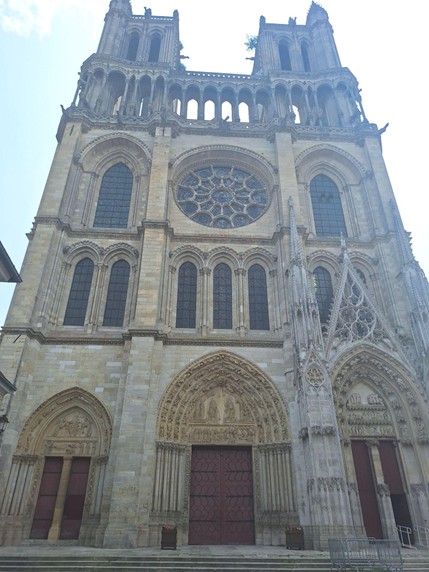
According to Adams, “The church towers at Mantes are very interesting, inside and out; they are evidently studied with love and labour by their designer; yet they have no fleches. How happens it that Notre Dame at Paris also has no fleches, although the towers, according to Viollet-le-Duc, are finished in full preparation for them? This double omission on the part of the French architect seems exceedingly strange, because his rival at Chartres finished his fleche just when the architect of Paris and Mantes was finishing his towers (1175-1200).”
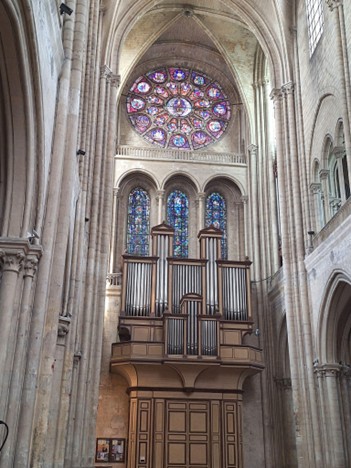
Furthermore, Adams states that “this rose [window] of Mantes is the first Gothic rose of great dimensions, and that from which the others grew; in its simplicity, its honesty, its large liberality of plan, it is also one of the best, if M. Viollet-le-Duc is a true guide”
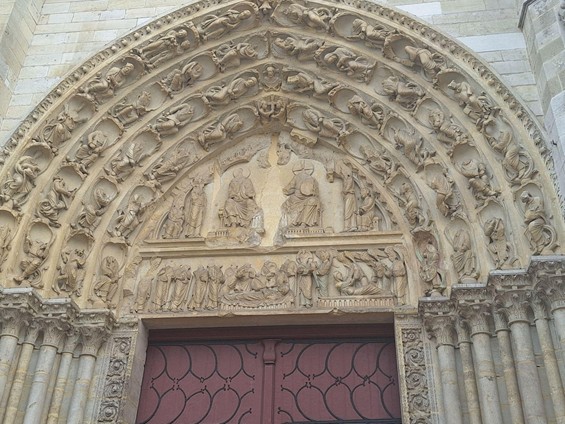
At the west portal most of the statues were decapitated in 1794 during the revolution.
The battles over Mantes continued for centuries after William was mortally wounded there in 1087, and during the Hundred Years’ War (Battle of Soindres). I imagine these battles were in the mind of General George Patton when he was the first of the allies to cross the Seine with the Third Army in August of 1944. The town was severely damaged many times over its history due to these battles. But there has been another form of destruction that has plagued the town since the war.
Social engineering through large scale public housing projects have been an affliction on the human and environmental condition wherever they have been implemented. I grew up in Chicago so I am familiar with the notorious Cabrini–Green Homes – Wikipedia project.
…Cabrini–Green was located at the boundary of two of Chicago’s wealthiest neighborhoods, Lincoln Park and the Gold Coast, and less than a mile from the Magnificent Mile. Despite its proximity to affluent areas, the complex was marked by high poverty rates. Gang activity was prominent, with individual gangs controlling specific buildings, and residents often felt compelled to affiliate with them for protection.
Unlike in the US where the projects were placed in the inner cities, in France the housing projects were placed outside of the cities in the banlieue (suburbs). Mantes-la-Jolie is at the end of the suburban train lines J and N serving Paris.

Suburban train lines between Mantes-la-Jolie and Paris.
I believe that Mantes-la-Jolie is better known today as being one of the hell holes of France than the site of a beautiful Medieval church. The Le Val Fourré — Wikipédia housing project was conceived in the 1950s and construction was largely completed in the 60s. It only took until the early 90s that it was realized that it was a failure and some buildings were demolished. Since then there have been continuing attempts to save the project, but the crime persists.
The district has been classified as a priority security zone since 2012, with increased numbers of national police officers. Indeed, the commune “suffers more than others from daily insecurity and deep-rooted delinquency”[14] and “has experienced a significant deterioration in its security conditions in recent years”[14], which was identified as such by the Ministry of the Interior of the Jean-Marc Ayrault government, thus allowing this area to benefit from additional police officers. (translated by Google from Wikipedia)

The Val Fourré district of Mantes-la-Jolie.
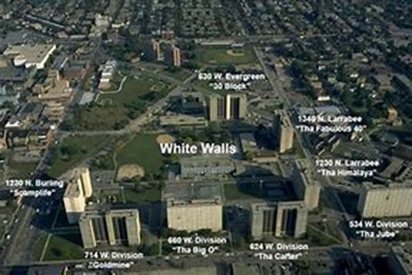
The Cabrini–Green Homes public housing project in Chicago.
According to a recent article (A Mantes-la-Jolie, le Val Fourré, l’un des quartiers les plus pauvres de France, poursuit sa mue | Les Echos) two more high rise buildings are scheduled to be demolished.
Published on April 18, 2025 at 10:43 AM Updated on April 21, 2025 at 3:29 PM
In a few weeks, Europe’s largest hydraulic crane, standing 70 meters high, will begin chipping away at two high-rise buildings still standing in the Val Fourré district of Mantes-la-Jolie (Yvelines). Built in the 1960s, these two Ader towers, each around twenty stories high, are a symbol of the urban planning then in vogue. Their demolition will mark the beginning of a broader renovation of the area.
It has now been 25 years since the rehabilitation of Val Fourré, which now has a population of 20,000. More than half of the 110-hectare neighborhood, one of the poorest in France, has already been transformed and around fifteen towers demolished… For an estimated cost of over €420 million. (translated by Google)
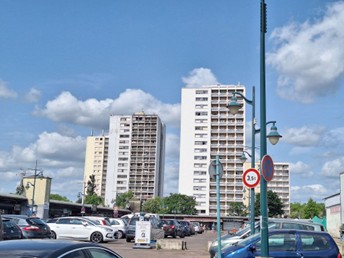
On my visit I did not see the crane taking down the buildings.
My conclusion, the building project that is the church has been a beautiful blessing for Mantes for over 800 years, while the socialist scheme of the Val Fourée has been a baleful blight for virtually all of its 80 years.
Notes
Adams relies heavily on the 19 century French architect Eugène Viollet-le-Duc for his descriptions and analysis of Medieval French architecture. Viollet-le-Duc was the architect of many renovations of Medieval buildings including Notre Dame de Paris that added the spire. It was shocking to see this spire collapse during the 2019 fire.
At the end of my 2015 article about Vidal’s Empire I compared Trump to William Randolph Hearst as he was characterized in the novel.
There is the crux of the reason for Trump’s popularity; by approaching the politically incorrect immigration issue head on he gives the impression that because he is rich he cannot be bought. However, in the end Hearst was denied the Democratic nomination through backroom deals at the party convention. For all his power and wealth, Hearst was usually denied in his several attempts at elective office (with the exception of a stint in the US House of Representatives). We can be assured that in all the political back rooms in the country there are discussions and plots being hatched to block Trump. We might expect, as Rockwell has supposed, that “the regime might even roll out one of its lone-nut gunmen” to solve the problem.













